The Intel Haswell Refresh Review: Core i7-4790, i5-4690 and i3-4360 Tested
by Ian Cutress on May 11, 2014 3:01 AM ESTSYSMark and Scientific Benchmarks
SYSmark 2014
SYSmark is developed by BAPCo, the Business Applications Performance Corporation, which includes in its current members Intel, Dell, Lenovo, Microsoft, Samsung, Sony, and Toshiba. The latest version of SYSmark, SYSmark 2014, uses the latest software packages from Adobe and Microsoft and meshes them together into a stringent testing package that can take a couple of hours to run. The end result gives marks for in office productivity, media creation and data/financial analysis sections as well as an overall result. SYSmark uses a standard office computer (an i3-4130 with a 500GB mechanical drive, 4GB DRAM, 1080p, integrated HD4400 graphics) to provide a benchmark score of ‘1000’, and all results are compared to this. Our testing runs the processors at 1080p with integrated graphics on an OCZ Vertex 3 240GB SSD.
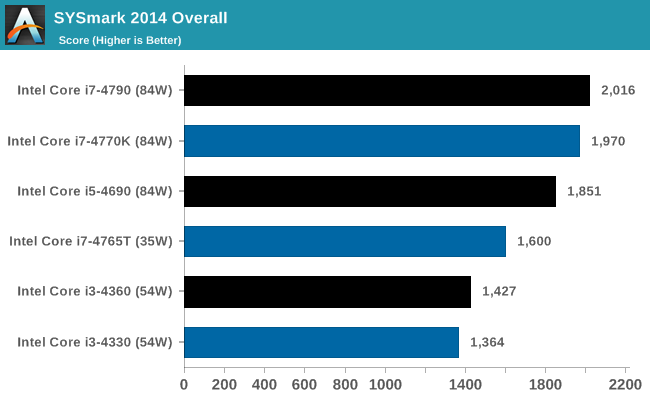
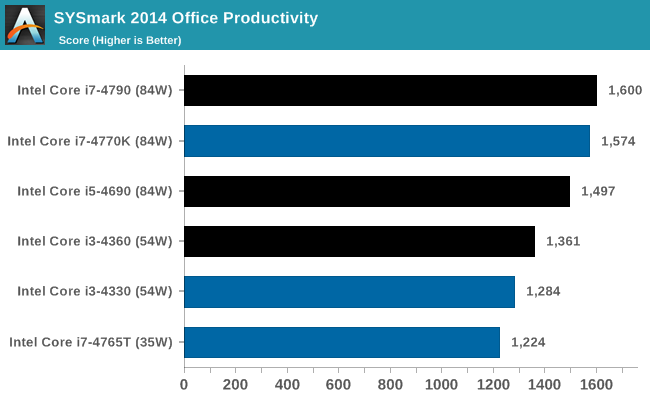
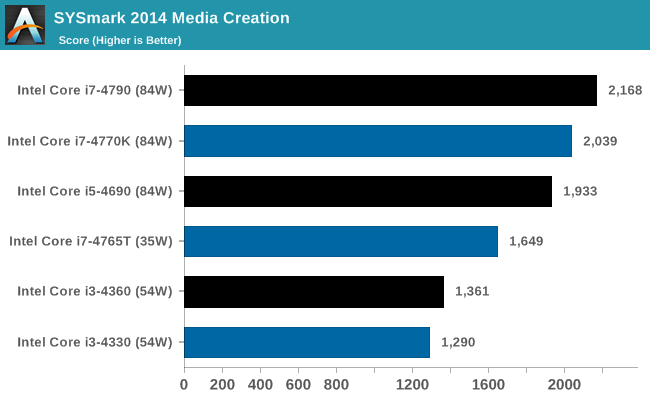
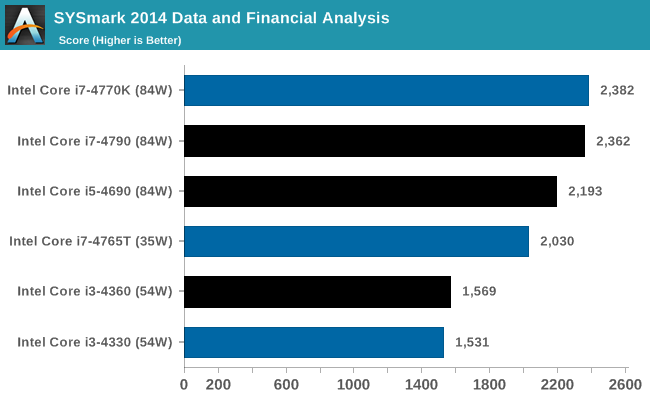
As we have not tested SYSmark 2014 with other CPUs yet, our results are rather limited, however the overall results are in line with what we would expect.
Point Calculations – 3D Movement Algorithm Test: link
3DPM is a self-penned benchmark, taking basic 3D movement algorithms used in Brownian Motion simulations and testing them for speed. High floating point performance, MHz and IPC wins in the single thread version, whereas the multithread version has to handle the threads and loves more cores.
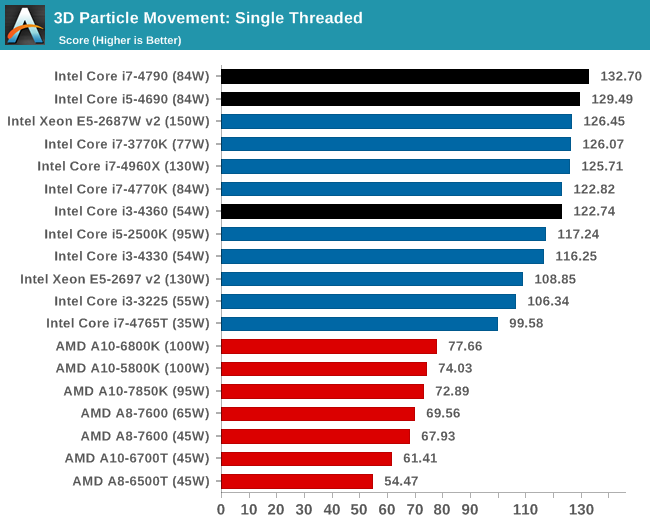
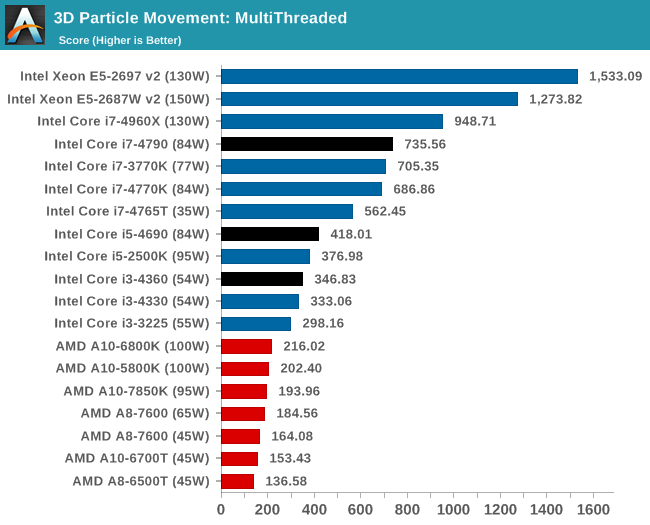










130 Comments
View All Comments
etamin - Sunday, May 11, 2014 - link
I feel that a whole lot of unnecessary effort was put into the benchmarks. But we appreciate the effort of course.I'm looking forward to SATA Express. Are there any compatible consumer level M.2 SSDs currently available?
weilin - Monday, May 12, 2014 - link
Yup, look for the models below in M.2 interfaceIntel: 530
Crucial: M500, M550
Misc: MyDigitalSSD, Samsung (only second hand/OEM stuff, no retail presence)
jjj - Sunday, May 11, 2014 - link
But there is competition, more than they ever had. You got tablets and phones killing PC sales and Intel is just sabotaging the only PC segment able to create any hype around PC. There is nobody else that really gives a damn about their products but hey they would rather have 60% margins instead of 58% even if they lose us too.Instead of giving us a 300$ 8 cores chip with no GPU, they are giving away free tablet Atom because that will help.....
juhatus - Sunday, May 11, 2014 - link
I totally agree, Intel should really push PC again, not replace schim's with better ones.bji - Sunday, May 11, 2014 - link
Intel cannot generate sufficient returns on its R & D dollars anymore. Nobody in the consumer market cares that much about faster Intel chips except CPU enthusiasts, and it's not a market that can even come close to supplying enough money to fund the R & D necessary to significantly advance x86 performance.You can blame AMD for not supplying enough competition, but a bigger part of the equation is that faster Intel chips don't sell "enough more" than current generation ones to justify spending huge amounts of R & D money on them.
You can look at this as a sad fact, but I actually like it. I can by a laptop now for cheap that is so overly spec'd for my needs that I essentially never need to upgrade, saving me money. Software companies cannot depend upon ever increasing chip speeds, they have to become better at producing efficient software in order to have the headroom for new features that used to be provided by ever increasing chip speed.
Advances in mobile computing are where it's at, and everyone knows that already ...
Antronman - Monday, May 12, 2014 - link
Buddy, you've never built a PC, and I'm assuming that you don't have a hardware-heavy job.bji - Monday, May 12, 2014 - link
Wrong on both counts.Shadowself - Monday, May 12, 2014 - link
To some extent you're correct, but the reality is that the reasons are interdependent.Current performance increases from one generation to the next (Sandy Bridge to Ivy Bridge to Haswell and anticipated into Broadwell) are only 10% - 20% per generation. I, and many like me, buy at the top of the performance range and now use that machine for a few years so that we get a significant performance jump with each new machine purchased. Back 20+ years ago when each generation was 50% to 100% faster I upgraded each generation. It's just not worth it to do so anymore for just a 10% - 20% increase. The aggregate cost of purchasing machines every generation over a few years for such moderate increases in performance is too high.
Likely Intel (and AMD) are into the range of diminishing returns on performance increases. Unless there are huge architecture changes in the upcoming Skylake series I expect the 10% - 20% increase per generation to continue for at least three more generations -- Haswell to Broadwell, Broadwell to Skylake, and Skylake to Cannonlake -- (and maybe go to 5% -10% performance increase in the Skylake to Cannonlake transition).
Small increases in performance keep people from buying every generation. People not buying every generation limits profits and what can be put into IR&D. Limited IR&D produces small increases in performance. And the cycle repeats.
alacard - Monday, May 12, 2014 - link
The increases over the past few generations have been no where near 10-20 percent.Sandy to Ivy was ~5 with that increase coming solely from power management/boost tweak. Clock for clock the cores perform identical (to get this metric you simply disable all the power management/boost functions in the bios and benchmark from there) with Ivy offering a slight decrease in consumed wattage.
The Ive to Haswell performance increase - with a few exceptions - is < 10% in almost all tests, with consumed wattage actually increasing from ivy.
Unfortunately, the Intel performance curve over the past 4 years is actually far more compressed than you paint in your post. With the exception of a couple of new task specific instructions we've had essentially less than 10% performance gains during that time
BadThad - Monday, May 12, 2014 - link
I agree Shadowself! I'm actually still mainly on a Q6600 system as it meets all of my needs. At last I'm at the point where I'm going to Z97 as the performance benefits and feature sets are finally worth it for my needs.